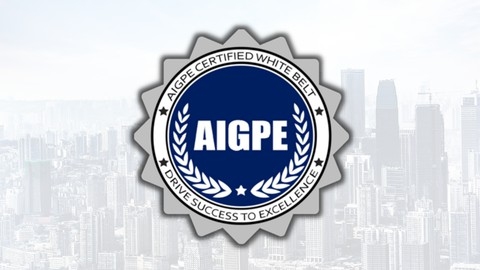Lean Six Sigma is a powerful methodology that combines the principles of Lean manufacturing and Six Sigma to improve processes, reduce waste, and enhance efficiency.
Lean Six Sigma White Belts are trained to identify and eliminate waste in their processes, applying basic tools and concepts to drive continuous improvement within their organizations.
Gaining this certification can be a valuable asset for your professional development, showing your commitment to enhancing productivity and quality.
Finding the right Lean Six Sigma White Belt course on Udemy can be a daunting task, especially with so many options available.
You’re looking for a course that goes beyond theory, providing practical experience and hands-on projects to solidify your understanding.
We’ve reviewed countless courses and based on our analysis, Six Sigma: Certified Lean Six Sigma White Belt (Accredited) is the best course on Udemy overall.
This course provides a strong foundation in the fundamentals of Lean and Six Sigma methodologies, with a focus on practical application.
It covers the historical context of continuous improvement, its evolution in the face of the Fourth Industrial Revolution, and how it’s reshaping the modern workplace.
The program also equips you with the tools to identify and address inefficiencies in your own work environment, teaching you how to leverage Lean and Six Sigma principles to improve workflows, reduce waste, and optimize performance.
This is just the beginning of our exploration of Udemy’s Lean Six Sigma White Belt courses.
Keep reading for more recommendations tailored to your specific needs and learning style.
We’ll cover courses focused on different aspects of Lean Six Sigma, as well as those designed for beginners, intermediate learners, and experts.
Six Sigma: Certified Lean Six Sigma White Belt (Accredited)
If you’re looking to dip your toes into the world of Lean Six Sigma, this course provides a solid foundation.
It’s a beginner-friendly introduction to the methodology, focusing on the core principles and tools that will equip you to start improving processes in your own workplace.
You’ll dive into the history and principles of Six Sigma, learning about the DMAIC model and the seven basic tools of quality.
These include familiar tools like process mapping (SIPOC), check sheets, and histograms, as well as less common ones like the 5 Why Analysis and run charts.
You’ll get hands-on practice with these tools through exercises and examples, learning how to create them using spreadsheets.
Beyond the Six Sigma framework, you’ll also explore the concepts of Lean and Kaizen, understanding how to identify and eliminate waste in your processes.
This gives you a more holistic perspective on process improvement.
The course is led by experienced instructors who are Six Sigma Master Black Belts and industry professionals.
They bring real-world experience and a passion for Six Sigma that comes through in the content.
Upon completion, you’ll receive a Certified Lean Six Sigma White Belt certification, a valuable addition to your resume that demonstrates your commitment to process improvement.
You’ll be able to confidently explain Six Sigma to others, create SIPOC diagrams, analyze data using basic graphical tools, and apply the 5 Why Analysis to identify root causes of problems.
This course is a good starting point for anyone interested in exploring the world of Lean Six Sigma.
However, if you already have a strong understanding of Six Sigma concepts, you might find the pace a bit slow.
Certified Lean Six Sigma White/Lean Six Sigma Yellow Belt
If you’re looking to gain a foundational understanding of Lean Six Sigma, this course offers a comprehensive introduction to the methodology.
Divided into a White Belt and a Yellow Belt section, it provides a structured path to learning the key concepts and practical applications.
In the White Belt section, you’ll be introduced to the history, goals, and different roles within Lean Six Sigma.
The course utilizes a real-world project as a case study, illustrating how the DMAIC cycle is used in practice.
This section also explores how Lean Six Sigma compares to other methodologies like Agile and Scrum, providing you with a broader perspective.
Moving on to the Yellow Belt section, you’ll delve deeper into the Seven Tools of Quality.
You’ll learn how to effectively utilize tools like Pareto Charts, Flowcharts, Fishbone Diagrams, Scatter Plots, and Histograms to identify areas for improvement.
These tools aren’t just theoretical concepts; you’ll be guided through practical exercises, allowing you to apply them to real-world scenarios.
The course concludes with a bonus lecture that further enhances your understanding.
This comprehensive approach, coupled with the real-world examples and practical exercises, makes this course an ideal starting point for anyone seeking to understand the principles and tools of Lean Six Sigma.
Dual Certification Lean Six Sigma White Belt and Yellow Belt
You’ll start with the basics of Six Sigma and its history, gaining a clear understanding of how it aims to eliminate defects and improve processes.
From there, you’ll delve into Lean principles, exploring how they enhance business efficiency through waste reduction and optimization.
The course emphasizes the DMAIC cycle, a structured problem-solving methodology central to Six Sigma.
You’ll learn how to effectively apply tools like Pareto Analysis, Fishbone Diagram, and Control Charts to identify and address root causes of issues.
One of the standout features of this course is its practical focus on software integration.
You’ll learn how to utilize Minitab, a powerful statistical software package, to analyze data and create insightful charts – a valuable skill in numerous industries.
To reinforce your learning and make the concepts real, the course incorporates a wealth of practice materials.
Quizzes, practice tests, and simulated case studies challenge you to apply what you’ve learned and build confidence in using Lean Six Sigma concepts in real-world scenarios.
This hands-on approach also prepares you for the certification exams included in the course.
The course’s inclusion of case studies featuring Fortune 500 companies like Toyota, Intel, and Bank of America is especially valuable.
These examples illustrate how these industry giants leverage Lean Six Sigma tools to achieve success, providing real-world context and inspiration for your own application of these concepts.
Whether you’re seeking a career change or simply aiming to enhance your business acumen, this course provides a solid foundation in Lean Six Sigma.
Lean Six Sigma Champion White Belt
This Lean Six Sigma Champion White Belt course offers a solid introduction to the principles and practices of Lean and Six Sigma.
This course starts with a clear overview of both methodologies, introducing you to the concepts of waste reduction and process improvement.
You’ll learn the five core principles of Lean and how they tie into the Toyota Production System, providing a valuable foundation for understanding the benefits of Lean strategies.
The course also delves into the history of Six Sigma, highlighting the advantages of using this methodology for systematic improvement.
One of the course’s strengths lies in its detailed exploration of the 8 forms of waste.
You’ll learn to identify each type, understand the root causes, and discover general solutions for eliminating them.
From transportation and inventory waste to overproduction, overprocessing, and defects, this section provides practical tools for improving processes and enhancing efficiency.
You’ll also be introduced to the powerful PDCA cycle, a framework for implementing continuous improvement, and the Kaizen philosophy, which emphasizes incremental change for sustainable results.
These concepts are further reinforced through the course’s coverage of the 7 basic tools of quality, including flowcharts, Pareto charts, and cause-and-effect diagrams.
These tools are essential for analyzing data, identifying areas for improvement, and driving a culture of continuous improvement within your organization.
The course also introduces the 5S system, a proven method for creating a clean, organized, and efficient work environment.
You’ll also be well-prepared to pursue the Lean Strategies International certification, a valuable asset for those seeking to advance their careers in this field.
Professional Lean Six Sigma White Belt Certification
You’re on the hunt for a top-notch Lean Six Sigma White Belt course, and this one deserves a serious look.
Robert Pyre, a certified Master Black Belt in Lean Six Sigma, delivers a comprehensive introduction to this powerful methodology for process improvement.
This course isn’t just theory.
You’ll dive into the history of Lean Six Sigma, its core beliefs, and its key concepts, understanding the difference between Lean and Six Sigma and how they work together to eliminate waste and reduce variation.
You’ll also master the DMAIC methodology, the heart of Lean Six Sigma, and gain a clear picture of the various levels of certification and roles available.
But it gets practical too.
You’ll be introduced to seven popular quality tools, such as Pareto charts and Fishbone diagrams, and get hands-on with case studies that bring the concepts to life.
Pyre’s teaching style is clear and engaging, making even complex concepts easy to grasp.
This course is ideal for anyone seeking to learn about Lean Six Sigma, whether you’re starting from scratch or looking to solidify existing knowledge.
No prior experience is required, so you can jump right in and begin your journey to mastering this valuable skillset.
Lean Six Sigma White Belt: Certification
This comprehensive course equips you with the knowledge and tools to drive impactful quality improvement initiatives.
You’ll embark on a journey from the fundamental principles of quality to the practical application of powerful methodologies like Lean and Six Sigma.
The course begins by grounding you in the concept of quality itself, exploring its importance in various aspects of your life and work.
You’ll delve into the Seven Tools of Quality, forming a solid foundation for understanding process improvement techniques.
Next, you’ll dive into the world of Lean, where you’ll learn to identify and eliminate waste in your processes.
The course provides a detailed exploration of the eight wastes, equipping you to maximize value and streamline your workflow.
Six Sigma, a powerful methodology for achieving near-perfect quality, is then introduced.
You’ll gain a thorough understanding of Six Sigma’s history, its benefits and drawbacks, and the different roles and levels within a Six Sigma framework.
Understanding your customer is paramount in any quality improvement endeavor.
This course provides a deep dive into the Voice of the Customer, empowering you to collect data, analyze expectations, and prioritize critical quality factors.
The course then equips you with practical tools to implement improvements.
You’ll learn how to effectively utilize the Seven Tools of Quality, including process mapping, check sheets, histograms, Pareto charts, fishbone diagrams, 5 Whys analysis, and run charts.
You’ll have the opportunity to practice these tools and apply them to real-world situations.
Finally, you’ll learn the DMAIC approach, a structured methodology for process improvement.
The course features a case study where you can apply DMAIC in a realistic setting, gaining hands-on experience with this powerful method.
This course is an invaluable resource for individuals seeking to make a real difference in their workplace.
It provides a comprehensive understanding of quality improvement concepts, practical tools, and methodologies, setting you on a path to achieving sustainable success.
Lean Six Sigma White Belt Certificate - Official
This course effectively covers the foundational principles of both Six Sigma and Lean methodologies, equipping you with the knowledge to identify and eliminate waste in your processes.
This, in turn, can lead to improvements in efficiency and quality.
The course dives into core concepts, like the Six Sigma mindset, emphasizing data-driven decision-making and continuous improvement.
You’ll also learn about the Lean mindset, which focuses on streamlining processes by eliminating unnecessary steps.
The curriculum clearly explains the differences between Six Sigma and Lean Six Sigma, showing how they work together to create a robust improvement system.
The course culminates with a certification test.
Passing this test earns you a White Belt certification, which can be a valuable addition to your professional profile.
If you’re interested in pursuing advanced levels of Lean Six Sigma training, this course provides a strong foundation.
While the course offers a good overview, you may find that it benefits from more in-depth coverage of certain topics.
For example, the explanation of statistical tools could be expanded to include practical applications.
Additionally, the course could benefit from more real-world case studies that illustrate how the concepts are applied in different industries.
It’s well-structured and provides a solid foundation for further learning.
However, consider exploring other resources alongside it to gain a more comprehensive and practical understanding.
Six Sigma: Lean Six Sigma White Belt (CSSC Accredited)
You’ll gain a comprehensive understanding of the historical context of continuous improvement, its evolution in the face of the Fourth Industrial Revolution, and how it’s reshaping the modern workplace.
The course delves into the core principles of Lean and Six Sigma, emphasizing their practical application.
You’ll learn about the various Lean Six Sigma Belts and their roles in project success, as well as the importance of standard work and visual management for streamlining processes and enhancing organizational transparency.
The program’s focus on practical application will equip you with the tools to identify and address inefficiencies in your own work environment.
You’ll learn how to leverage Lean and Six Sigma principles to improve workflows, reduce waste, and optimize performance.
While the course provides a strong introduction to Lean Six Sigma, it’s important to note that a White Belt certification serves as a starting point.
If you’re looking to delve deeper into the methodologies and pursue advanced applications, you may want to consider further training.
The final exam will assess your understanding of the course material, and upon successful completion, you’ll receive your LSSWB certificate, validating your foundational knowledge in Lean Six Sigma.
This certification can be a valuable asset in demonstrating your commitment to continuous improvement and your understanding of these powerful methodologies.
Lean Six Sigma White Belt
Looking for a Lean Six Sigma White Belt course that gets you up to speed quickly?
This one hits the mark.
It doesn’t waste time with fluff.
Right from the start, you’re diving into the core concepts of Lean and Six Sigma – the “why” and the “what.”
You’ll gain a solid understanding of the Voice of the Customer, the 5 Principles of Lean, and the crucial role of waste and value streams.
You’ll also grasp how variation impacts processes within the Six Sigma framework.
But theory alone isn’t enough.
This course takes you through the practical side of Lean Six Sigma, introducing you to the DMAIC methodology – a structured approach to problem-solving.
You’ll learn about Kaizen, a continuous improvement process that emphasizes small, incremental changes, and Gemba, a technique for observing processes in their natural setting.
This course isn’t just about learning; it’s about doing.
You’ll test your knowledge with quizzes throughout, which will help solidify your understanding.
You’ll also learn about the different Lean Six Sigma belt levels, giving you a roadmap for your continuous improvement journey.
Certified Lean Six Sigma White Belt
This “Certified Lean Six Sigma White Belt” course is a solid entry point into the world of continuous improvement.
You’ll dive into the foundational principles of both Six Sigma and Lean Manufacturing, exploring their historical roots and distinct approaches to process optimization.
Instead of just learning theory, you’ll get your hands dirty with practical tools like the seven Mudas (types of waste) and the six M’s (factors affecting a process).
These tools are essential for identifying and addressing bottlenecks in any process, and you’ll gain valuable hands-on experience through the course.
Imagine using these tools to analyze and streamline processes within your own workplace - the impact could be significant.
The course also covers the seven quality tools, providing a robust framework for problem-solving and continuous improvement.
You’ll learn how to effectively apply these tools in real-world scenarios, making this course more than just a theoretical exercise.
Even if you’re not aiming for a higher-level Lean Six Sigma certification, this course will equip you with a valuable set of principles and techniques for optimizing processes and driving efficiency.
Plus, you’ll receive downloadable materials on the six M’s and seven Mudas, along with a printable certificate of completion, making it a valuable investment for your professional development.










